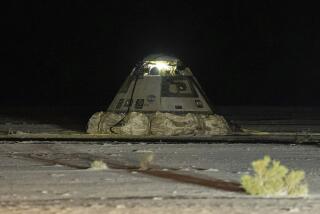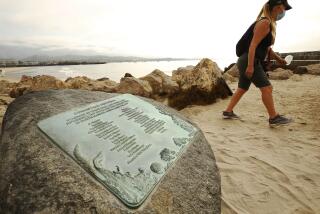Oft-Delayed Shuttle Test Successful : Firing of 3 Main Engines Sets Stage for Discovery Flight
KENNEDY SPACE CENTER, Fla. — Putting a series of frustrating delays behind them, NASA engineers Wednesday test-fired the space shuttle Discovery’s main engines in a major step toward reviving the nation’s manned space program.
Senior shuttle program officials declared the 20-second test firing an unqualified success demonstrating Discovery’s readiness to fly 30 months after the shuttle Challenger exploded on Jan. 28, 1986. That accident grounded the single major type of launch vehicle available to U.S. civilian and military space programs.
With minor exceptions, officials said, the test duplicated the conditions of an actual launch up to the moment of liftoff.
NASA Administrator James C. Fletcher, who observed the test from the Kennedy Space Center’s launch control facility, seconded these upbeat appraisals, congratulating a “super team” for what he said was a “super job.”
“We proved that it works and it works well,’ said Robert L. Crippen, the Navy captain who piloted the first shuttle in 1981 and now, under a drastically revised safety management system, holds final authority over launch decisions.
“We have a well-oiled piece of equipment, and it makes me feel very comfortable,” Crippen told a news conference after engineers had spent four hours analyzing test data gathered from 700 sensors on the shuttle.
“We have not seen anything today that would delay us from marching on,” Crippen said.
He and other officials nevertheless refrained from setting a firm launch date for Discovery--which was originally scheduled to fly on June 2--until Wednesday’s test is analyzed in more detail.
‘A Shot at September’
“We still have a shot at September,” Crippen noted, adding emphatically that “we want to launch just as soon as it’s safe to do so.”
Officials described the FRF, or Flight-Readiness Firing, as the single most hazardous--but also the most revealing--prelaunch test of the shuttle. Its huge external fuel tank fully loaded with half a million gallons of liquid hydrogen and oxygen, the shuttle’s engines reached 100% of their combined 1.1 million pounds of thrust.
Although the three engines alone were not powerful enough to counter the 5.5-million pound weight of the spacecraft, its fuel and its two solid-fuel booster rockets, eight huge bolts were needed to pin the shuttle down and prevent vibrations from “walking” it across the launch pad. Computers were programmed to prevent the boosters from firing.
Brilliant orange flame and the distinctive, hollow thunder of the space shuttle erupted from the Discovery’s engines on schedule at 7:30 in the morning, sending a mushroom cloud of white smoke into the humid sky.
As the engines ignited, flight controllers, watching from a distance of 4.2 miles, cheered and clapped, and some wept.
This was the first ignition of a space shuttle on the launch pad since the Challenger disaster, in which seven crew members died in an explosion 73 seconds after launch. For many it seemed as much a psychological milestone as a procedural hurdle--an affirmation of skill and a lift for morale.
‘Closer to Launch’
“Everything we’ve been doing for the past two years comes down to this,” said Jack Harper, a senior quality control inspector on the shuttle orbiter. “We’re that much closer to launch.”
“When you see those engines light off, when you see the smoke come up and you feel the energy of those engines, that’s the top moment,” Harper said in a conversation after the test.
“The toughest guys I know here cry every time you get a launch or a firing,” added Charles T. Reece, the Lockheed Corp.’s manager of quality control for the shuttle orbiter. “They can’t talk to you for a while. It’s really wonderful.”
Thomas E. Utsman, shuttle program director at the Kennedy Space Center, called the test a “major, major accomplishment” that not only proved Discovery’s flight worthiness but brought an “obvious sense of relief” to the thousands of men and women who have built and coddled it.
The test was only the sixth such hold-down firing in the history of the shuttle program. The previous five, including two for the ill-fated Challenger, were conducted before the maiden flights of new shuttle orbiters.
Discovery has flown six times before. Officials said the decision to proof test it again partly reflected a new conservatism toward safety that has grown out of the Challenger disaster, and partly the fact that many changes have been made in the system over the past two years.
400 Changes Made
Two of Discovery’s three engines are new, and the space agency has made some 400 changes at a cost of $800 million in the winged orbiters, the shuttle’s huge external fuel tanks, and the solid-fuel booster rockets that were most directly at fault in the accident. A defectively designed seal in a joint between two segments of one booster was found to have caused the Challenger to explode.
Wednesday’s test, originally planned for July 28, was delayed four times by problems in ground equipment and a fifth time last week, when a computer, sensing that a small valve in one engine’s fuel system had failed to close sufficiently, stopped the test moments before ignition.
Officials said the problem was minor, probably the result of a defective sensor, but decided anyway to replace the entire valve. The new unit performed normally.
Still to be fixed is a slow gas leak in a hard-to-reach cranny of the orbital maneuver system, the set of thrusters that allows the shuttle to adjust its position while in orbit. The solution, officials said, will be to cut two small holes in the tail section, reach in with a tool that surrounds the tiny leak with a “clamshell” mold and inject a graphite and silicone putty to seal it.
Although officials have said it would probably do no harm to fly with the leak, the new conservatism dictates fixing it--an approach that has stirred suggestions that the space agency has swung from complacency to an obsession with safety that may prove counter-productive.
“NASA’s dotting every ‘i’ and crossing every ‘t’ to make sure the next shuttle flight will be as safe as possible,” Sen. Jake Garn (R-Utah) told CBS News last week.
‘Little’ Too Cautious
Garn, who flew aboard the Discovery in April, 1985, said he had begun to think that “at this point we probably are being a little bit too cautious because of all the attention.”
Critics of the manned space program have seized on the numerous glitches in preparing Discovery for launch as further evidence that the system is simply too complex to ensure its reliability.
To that, Crippen replied Wednesday:
“We knew we were going to have growing pains getting it back flying again. It is a complicated machine. But it is also a fantastic flying machine . . . I expect to demonstrate that performance in the future.”
More to Read
Sign up for Essential California
The most important California stories and recommendations in your inbox every morning.
You may occasionally receive promotional content from the Los Angeles Times.










